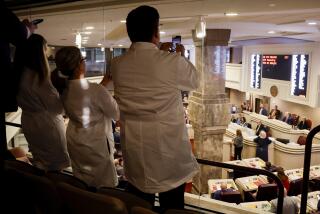Stem cell games
- Share via
TO SCIENTISTS, amniotic stem cells are tools that could help make life-saving treatments for human ailments. To religiously conservative politicians, they are an excuse to disregard embryonic stem cell research altogether. And to the House of Representatives, they provide a useful reminder of the importance of overturning the federal ban on embryonic stem cell research.
Research published this week shows that stem cells harvested from amniotic fluid -- easily accomplished through the common practice of amniocentesis -- can be used to create human tissues. Unlike embryonic stem cells, they do not appear to form tumors when implanted in animals. And they do not raise the same religious or ethical objections as embryonic stem cells because no embryos are destroyed in the process.
This could be an impressive new medical tool. But it also could be a convenient pretext for pushing embryonic stem cell research aside -- and that shouldn’t be allowed to happen. For all the potential uses of amniotic cells, they are likely to prove less adaptable than embryonic cells. Exclusive focus on amniotic stem cells would divert attention and time away from potentially more promising lines of research.
All new science in the stem cell field is welcome. But because of President Bush’s adamant refusal to fund most embryonic stem cell research, too much scientific effort is being pressed into finding ways around religious opposition to the field instead of furthering the search for treatments.
Less than six months ago, another scientific research team announced that it had found a way to use a single cell from early stage embryos to create stem cells, which would quell some opposition because the method does not destroy an embryo.
The House came up with a better solution Thursday, passing a bill that would extend federal funding of stem cell research to embryos that would have been discarded by fertility clinics anyway. Although the bill passed 253 to 174 -- a clear and commanding margin -- it falls short of the two-thirds needed to override the president’s promised veto. That’s a shame, but at least it vividly illustrates to the public -- which largely favors stem cell research -- exactly who is responsible for halting progress.






